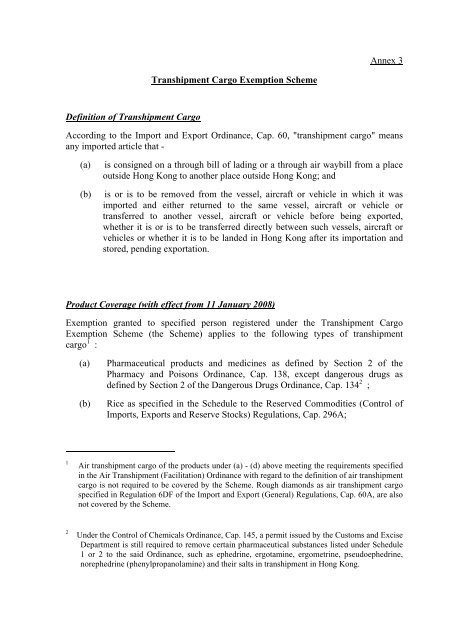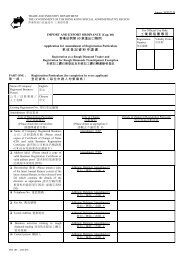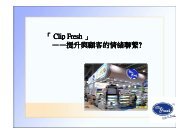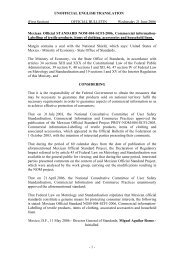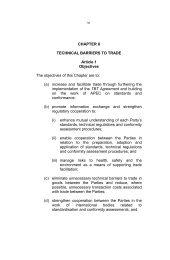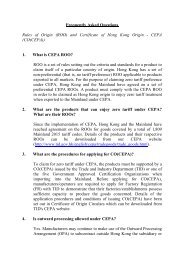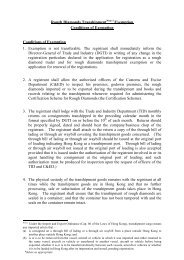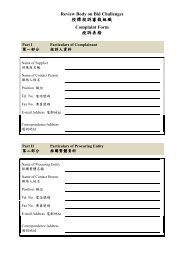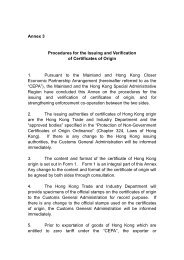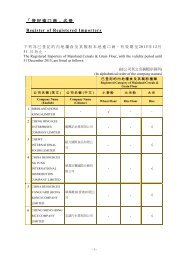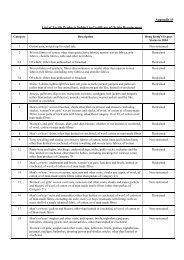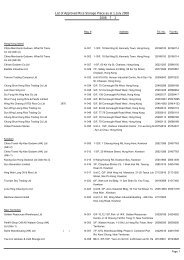Annex 3 Transhipment Cargo Exemption Scheme Definition of ...
Annex 3 Transhipment Cargo Exemption Scheme Definition of ...
Annex 3 Transhipment Cargo Exemption Scheme Definition of ...
You also want an ePaper? Increase the reach of your titles
YUMPU automatically turns print PDFs into web optimized ePapers that Google loves.
<strong>Annex</strong> 3<br />
<strong>Transhipment</strong> <strong>Cargo</strong> <strong>Exemption</strong> <strong>Scheme</strong><br />
<strong>Definition</strong> <strong>of</strong> <strong>Transhipment</strong> <strong>Cargo</strong><br />
According to the Import and Export Ordinance, Cap. 60, "transhipment cargo" means<br />
any imported article that -<br />
(a)<br />
(b)<br />
is consigned on a through bill <strong>of</strong> lading or a through air waybill from a place<br />
outside Hong Kong to another place outside Hong Kong; and<br />
is or is to be removed from the vessel, aircraft or vehicle in which it was<br />
imported and either returned to the same vessel, aircraft or vehicle or<br />
transferred to another vessel, aircraft or vehicle before being exported,<br />
whether it is or is to be transferred directly between such vessels, aircraft or<br />
vehicles or whether it is to be landed in Hong Kong after its importation and<br />
stored, pending exportation.<br />
Product Coverage (with effect from 11 January 2008)<br />
<strong>Exemption</strong> granted to specified person registered under the <strong>Transhipment</strong> <strong>Cargo</strong><br />
<strong>Exemption</strong> <strong>Scheme</strong> (the <strong>Scheme</strong>) applies to the following types <strong>of</strong> transhipment<br />
cargo 1 :<br />
(a)<br />
(b)<br />
Pharmaceutical products and medicines as defined by Section 2 <strong>of</strong> the<br />
Pharmacy and Poisons Ordinance, Cap. 138, except dangerous drugs as<br />
defined by Section 2 <strong>of</strong> the Dangerous Drugs Ordinance, Cap. 134 2 ;<br />
Rice as specified in the Schedule to the Reserved Commodities (Control <strong>of</strong><br />
Imports, Exports and Reserve Stocks) Regulations, Cap. 296A;<br />
1<br />
Air transhipment cargo <strong>of</strong> the products under (a) - (d) above meeting the requirements specified<br />
in the Air <strong>Transhipment</strong> (Facilitation) Ordinance with regard to the definition <strong>of</strong> air transhipment<br />
cargo is not required to be covered by the <strong>Scheme</strong>. Rough diamonds as air transhipment cargo<br />
specified in Regulation 6DF <strong>of</strong> the Import and Export (General) Regulations, Cap. 60A, are also<br />
not covered by the <strong>Scheme</strong>.<br />
2<br />
Under the Control <strong>of</strong> Chemicals Ordinance, Cap. 145, a permit issued by the Customs and Excise<br />
Department is still required to remove certain pharmaceutical substances listed under Schedule<br />
1 or 2 to the said Ordinance, such as ephedrine, ergotamine, ergometrine, pseudoephedrine,<br />
norephedrine (phenylpropanolamine) and their salts in transhipment in Hong Kong.
(c)<br />
(d)<br />
(e)<br />
Frozen or chilled meat and poultry as specified in Part I <strong>of</strong> the First Schedule<br />
to the Import and Export (General) Regulations, Cap. 60A;<br />
Chinese herbal medicines and proprietary Chinese medicines as<br />
specified in Part I <strong>of</strong> the First Schedule and Part I <strong>of</strong> the Second<br />
Schedule to the Import and Export (General) Regulations, Cap 60A; and<br />
Rough diamonds as specified in Part I <strong>of</strong> the First Schedule and Part I <strong>of</strong> the<br />
Second Schedule to the Import and Export (General) Regulations, Cap. 60A.<br />
If importation <strong>of</strong> the products under (a) to (d) above from their country or place <strong>of</strong><br />
origin or exportation to their country or place <strong>of</strong> destination or transhipment route is<br />
subject to any trade sanctions under the United Nations Sanctions Ordinance, Cap. 537,<br />
the relevant transhipment cargoes are not eligible for any licensing exemption under the<br />
<strong>Scheme</strong>.<br />
For rough diamonds under (e) above, the exemption only applies to transhipment <strong>of</strong><br />
rough diamonds from or to a country or place for which the Kimberley Process<br />
Certification <strong>Scheme</strong> is effective or as permitted by the Kimberley Process (KP) 3 and<br />
the importation <strong>of</strong> the rough diamonds from the exporting country or place and<br />
exportation <strong>of</strong> which to the country or place <strong>of</strong> destination are not subject to any trade<br />
sanctions.<br />
3 The Kimberley Process (KP) is a negotiating forum originated from discussions in the United<br />
Nations General Assembly (UNGA) regarding rebel activities in some parts <strong>of</strong> Africa. It seeks to<br />
stop trade in conflict diamonds (rough diamonds used by rebel movements or their allies to<br />
finance conflicts aimed at undermining legitimate governments, as described in relevant United<br />
Nations Security Council resolutions, and as understood and recognised in the relevant UNGA<br />
Resolutions) from fuelling armed conflicts, activities <strong>of</strong> rebel movements and illicit proliferation<br />
<strong>of</strong> armament. The KP Certification <strong>Scheme</strong> (KPCS) for rough diamonds was launched by the KP<br />
on 1 January 2003. Under the KPCS, Participants can only trade rough diamonds with countries<br />
or places as permitted by the KP. Traders may refer to the Seventh Schedule to the Import and<br />
Export (General) Regulations, Cap. 60A, for the list <strong>of</strong> such countries or place


